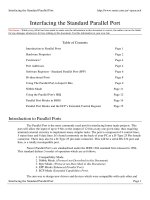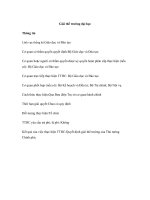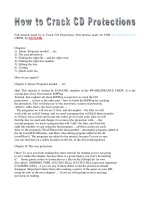Tài liệu How the PIX/ASA Firewall Works ppt
Bạn đang xem bản rút gọn của tài liệu. Xem và tải ngay bản đầy đủ của tài liệu tại đây (36.82 KB, 8 trang )
How the PIX/ASA Firewall Works
N
ote
With the implementation of the PIX and ASA software starting with version 7.0, many of
the features and functionality of the firewall were changed dramatically. Version 7.0 was
truly a major design shift. This chapter is written to include the 6.x software because, in
addition to the new 7.x software, that is the version of software that most Cisco PIX
firewalls are running. Where possible, we point out the new/changed features, commands
and functionality that is provided via the 7.0 code. If no note specifies which version of
software a command functions on, that means that the command is the exact same
regardless of whether the firewall is running 6.x or 7.x software. For more detailed
information about PIX 7.0 code, refer to the Cisco ASA and PIX Firewall Handbook
(Cisco Press).
Fundamentally, the PIX/ASA firewall functions by filtering traffic that is transmitted
through the firewall across the firewall interfaces. This allows the PIX/ASA to protect
hosts and networks from unauthorized access while still permitting access that is deemed
(and defined) by the administrator as acceptable. The firewall functionality performs
these tasks by parsing a security policy, functioning in a firewall mode of operation, and
performing stateful inspection of the data.
Firewall Security Policy
The firewall security policy (not to be confused with the general security policies
discussed in Chapter 10
, "Firewall Security Policies") on the PIX firewall is what
determines the traffic that will be permitted or denied by the firewall. To facilitate this,
the PIX implements a combination of the following elements to assist in making filtering
decisions:
• Separate the network into zones based on security levels
• Use ACLs to permit or deny traffic
• Apply Network Address Translation (NAT)
• Apply authentication, authorization, and accounting (AAA) for through traffic
• Apply web or FTP filtering
In addition, the Cisco ASA can perform the following:
• Use the Advanced Inspection and Prevention Security Services Module (AIP
SSM) to perform deep packet inspection on the data. The AIP SSM is beyond the
scope of this book.
• Use the CSC SSM to perform threat protection and content control for antivirus,
antispyware, antispam, antiphishing, URL blocking, content filtering, and file
blocking. The CSC SSM is beyond the scope of this book.
• Apply QoS policies to give priority to certain types of network traffic. QoS is
beyond the scope of this book.
Separate the Network into Zones Based on Security Levels
The PIX separates a network into separate zones based on their security level. These
security levels range from 0 (completely untrusted) to 100 (completely trusted).
Depending on the number of interfaces on a given PIX, there are at least two zones: 0
(outside interface) and 100 (inside interface). If there are additional interfaces on the PIX,
they can be assigned a security level value from 1 to 99. Traffic from higher-security
zones is allowed to pass to lower-security zones provided a translation rule is in place
(the translation rule is optional for 7.x). Traffic between zones of equal security is also
allowed to pass unimpeded, provided that the connections between resources have been
enabled.
Use ACLs to Permit or Deny Traffic
A fundamental aspect of almost all firewalls, including the PIX and ASA, is the use of
ACLs to define the list of traffic permitted or denied by the firewall. The PIX can use
multiple ACLs that can be applied independently to each interface on the firewall. For
PIX 6.x, the ACLs are always applied to inbound traffic on an interface. With PIX/ASA
7.x, this functionality has been expanded to allow the ACL to be applied to both inbound
and outbound traffic on an interface.
It is important to understand that the concept of inbound and outbound traffic in the
context of an ACL is based on the traffic direction on the given interface, not the network
that the traffic may have come from. For example, it is easy to think of an outbound ACL
as applying to traffic that is coming from the internal network (after all, the traffic is
going out of the network). This is not correct, however. From the perspective of the
firewall, that traffic would actually be inbound traffic on the internal network interface
and would be most effectively filtered by using an ACL that is applied to inbound traffic
on the internal network interface. An example of an ACL applying to outbound traffic is
the traffic permitted to exit an interface to a demilitarized zone (DMZ) segment.
Apply NAT
PIX firewalls can also use NAT to facilitate the use of private IP addresses on the internal
network, hide the local address of resources, and resolve IP routing problems due to
overlapping IP address ranges on connected networks. NAT is typically used any time
that traffic from a lower-security level interface is allowed to pass to a higher-security
level interface. This implementation typically requires the use of both an address
translation and an ACL.
The PIX uses two types of translation:
• Static translation An external address is assigned on a 1:1 basis to an internal
address. This is commonly referred to as traditional NAT.
• Dynamic translation An external address (or address pool) is assigned to an
internal address range (or ranges) and an address from that pool is dynamically
assigned on a first-come, first-serve basis. If all addresses in the pool are taken
then the PIX can dynamically switch to PAT, where a single external address can
provide translation to multiple internal addresses by mapping TCP and UDP port
numbers to unused port numbers on the translated address. In addition, PAT can
be configured without a NAT address pool, allowing a single external IP address
to perform all translations.
Two primary exceptions apply to this situation. First, if the hosts on the different
networks are not using NAT at all, as is typically the case with VPN connections,
translations are not required. Instead, the command nat 0 acl is used to specify the traffic
(based on the ACL) that should not be translated and rather should be directly transmitted
through the firewall.
The PIX 7.x code also changes this functionality in that translations are no longer
required; however, an ACL is still necessary. In this case, the traffic is either permitted or
denied as determined by a corresponding ACL.
Apply AAA for Through Traffic
Certain types of traffic, in particular HTTP traffic, can also require authentication and
authorization of the user attempting to initiate this traffic. This can be used to ensure that
only permitted users are able to pass the traffic in question through the firewall. In
addition the PIX can be configured to forward accounting information to a RADIUS or
TACACS+ server for reporting of usage.
Apply Web or FTP Filtering
The PIX and ASA can perform some rudimentary filtering of web (HTTP and HTTPS)
and FTP traffic by default. This functionality can be greatly enhanced through the use of
third-party content-filtering systems, allowing for granular filtering and control of access
to specific websites, FTP server, and many other Internet-based applications (such as
instant messenger and peer-to-peer file-sharing applications). In particular the following
Internet filtering products are supported for seamless integration with the PIX/ASA:
• Websense Enterprise
• Secure Computing SmartFiler (formerly Sentian by N2H2)
• CSC-SSM (although it is not as feature rich as the previous two solutions are and
is really tailored more to the small/medium environment that needs basic filtering
functionality)
Firewall Modes of Operation
Traditionally, PIX firewalls operated in a single mode of operation, known as routed
mode. This is the most common firewall mode of implementation and treats the firewall
as a router hop on the network. Devices on one side of the firewall are considered to be
on different subnets than devices on the other side of the firewall.
With the advent of PIX/ASA 7.x and the ASA security devices, a new mode of operation
known as transparent mode was implemented. In transparent mode, the firewall operates
more like a bridge than a router, transparently allowing traffic to traverse the firewall
without requiring additional router hops or manipulation of the data. Essentially, the same
network exists on both sides of the firewall. Because the firewall interfaces do not have
IP addresses assigned to them (at least not in the conventional sense, you still need to
assign an IP address to perform remote management of the firewall), the firewall is
commonly referred to as operating in stealth mode (because it is not easily detectable).
For most implementations, the firewall will be configured to operate in routed mode (and
this is the default operating mode). Some notable exceptions that lend themselves to
transparent mode are instances where you want a firewall that can filter traffic that would
be otherwise blocked by routed mode (for example, unsupported routing protocols or
multicast traffic). In addition, transparent mode firewalls can use EtherType ACLs to
allow the firewall to filter some types of non-IP traffic. Transparent firewalls can also be
used in situations where you do not want or need to re-IP address devices on each side of
the firewall, instead of leaving them as previously configured with no additional
configuration required.
Stateful Inspection
Stateful packet inspection lies at the heart of how PIX/ASA firewalls function. This
functionality is provided through a process known as the Cisco adaptive security
algorithm (ASA). The ASA uses a stateful approach to security. Every inbound packet is
checked exhaustively against the ASA and against connection state information in
memory. The ASA applies the following default rules (although this is by far not an
exhaustive list) to traffic coming into the PIX:
• Allow any traffic connections that originate from the inside, higher-security,
network to an external, lower-security network unless specifically denied by an
ACL.
• Allow any traffic for which application inspection has been configured and the
traffic has been determined to be acceptable traffic.
• Drop and log attempts to initiate connections to a translation slot (for example, a
server protected by the firewall) from the outside unless there is an ACL that
permits that connection.
• Drop and log source routed IP packets.
• Deny all Internet Control Message Protocol (ICMP) traffic from lower-security
interfaces through the firewall except if explicitly permitted. This prevents
responses to outbound ICMP traffic from being able to be successfully delivered
(for example, if an external host is pinged using an ICMP echo, the result will
appear to be a request timed out because the ICMP echo-reply packet will be
blocked on the external interface and never reach the original source host).
• Permit all ICMP traffic to the firewall itself (this can be disabled or controlled
with ICMP inspection).
• For PIX 6.x traffic may not exit the PIX firewall on the same network interface it
entered. For PIX 7.x, this is a configurable option.
The ASA allows connections from a higher-security interface to a lower-security
interface without an explicit configuration for each internal system and application, as
shown in Figure 6-1
.
Figure 6-1. Cisco PIX ASA Operation
[View full size image]
The ASA is always in operation and monitors all return packets to ensure they are valid.
This is done by checking the state table to determine whether the packet in question is a
response to a legitimate outbound connection. If it is, the packet is automatically
permitted (this is the definition of stateful packet inspection). In addition, the ASA
actively randomizes the TCP sequence numbers while ensuring that they stay within an
acceptable range to minimize the risk of TCP sequence number attack.
The ASA can also perform application inspection for certain types of traffic to determine
whether it should be permitted or denied.
Application Inspection
Application inspection is provided on the PIX firewall as a component of the ASA
through the use of fixups or inspections. For PIX/ASA 7.0, the fixup command has been
replaced by the use of the policy-map command. Functionally, the process is similar
between a fixup and a policy map.
Application inspection allows the firewall to perform additional inspection of certain
types of applications. In doing so, the firewall can make filtering decisions based not on
the protocol in use (for example, SMTP) but on the actual application (for example, only
allowing HELO, MAIL, RCPT, DATA, RSET, NOOP, and QUIT commands for SMTP
traffic).
Application inspection is performed on the following protocols/applications (PIX/ASA
versions older than 7.1 may not support all of these applications):
• ctiqbe This inspection allows for Cisco IP Softphone and other Cisco Telephony
Application Programming Interface/Java Telephony Application Programming
Interface (TAPI/JTAPI) applications to work across the firewall.
• dns This inspection allows you to define the maximum Domain Name System
(DNS) length. The default value is 512, which can cause issues with some
Microsoft DNS servers ( />).
• esmtp This inspection enables you to define the commands that will be allowed for
SMTP and ESMTP applications functioning across the firewall. Microsoft
Exchange servers can experience problems with certain ESMTP inspection
configurations ( />).
• ftp This inspection will prepare secondary channels for FTP data transfer, track the
FTP command-reference sequence, and generate and audit trail and NAT-
embedded IP addresses.
• gtp This inspection performs application inspection for the GPRS Tunneling
Protocol (GTP) that is used for providing secure access over wireless networks.
• h323 This inspection provides support for H.323-compliant applications such as
Cisco CallManager and VocalTec Gatekeeper. This allows it to NAT embed IP
addresses and dynamically allocate negotiated connections over different ports
than the initial connection was established.
• http This inspection provides for enhanced HTTP inspection (for example,
ensuring compliance with RFC 2616). It also allows the firewall to use URL
screening through third-party content-filtering software such as Websense or
Secure Computing. Finally, it provides for the ability to perform Java and ActiveX
filtering.
• icmp This inspection allows the firewall to perform stateful inspection of ICMP
traffic in a manner similar to how TCP and UDP traffic are inspected (for
example, by ensuring that only one response is generated for one request and that
the sequence numbers used are correct). Without this command, it is
recommended that ICMP traffic not be permitted through the firewall.
• icmp error This inspection allows the firewall to create xlates for intermediate
hops that send ICMP error message.
• ils This inspection provides NAT support for Microsoft NetMeeting, SiteServer,
and Active Directory products that use Lightweight Directory Access Protocol
(LDAP) to communicate with an Internet Locator Server (ILS).
• mgcp This inspection is used to support Call Agent and other media gateways.
• netbios This inspection performs inspection of NetBIOS traffic on UDP ports 137
and 138.
• pptp This inspection inspects PPTP protocol packets and dynamically creates the
generic routing encapsulation (GRE) connections and xlates required to permit the
PPTP traffic.
• rsh This inspection allows for RSH clients and servers to negotiate port numbers
for communications with each other.
• rtsp This inspection allows the firewall to permit RTSP packets such as those used
by RealAudio, RealNetworks, Apple QuickTime 4, RealPlayer, and Cisco IP/TV.
• sip This inspection is used to allow SIP Voice over IP (VoIP) calls to function
through the firewall by allowing the dynamic embryonic connections required by
SIP to be created.
• skinny This inspection is used to allow Skinny Client Control Protocol (SCCP)
VoIP services to function through the firewall.
• snmp This inspection is used to implement SNMP inspection in conjunction with
the use of the snmp-map command. You can also use this inspection to change the
ports that SNMP is listening on.
• sqlnet This inspection is used to ensure that the data stream for Oracle applications
is consistent on either side of the firewall and inspects the packets to determine
which embedded ports need to be opened for SQL*Net Version 1.
• sunrpc This inspection can be used to change the port that the firewall is listening
for Sun Remote Procedure Call (RPC) traffic and allows for the creation of
dynamic ports that are required for Sun RPC communications.
• tftp This inspection is used to create the dynamic connections and translations
required to facilitate TFTP file transfers.
• xdmcp This inspection is used to allow the dynamic connections and X Window
System sessions required to permit X Display Manager Control Protocol
(XDMCP) communications.









